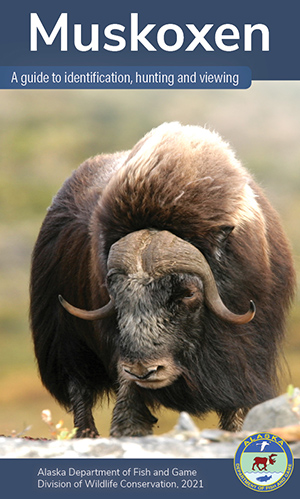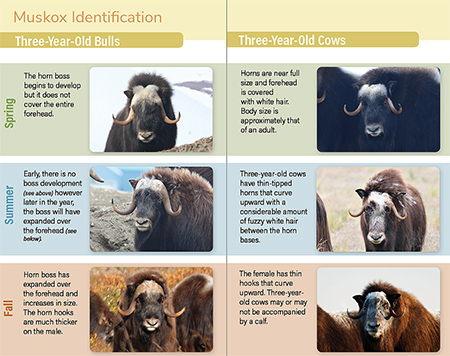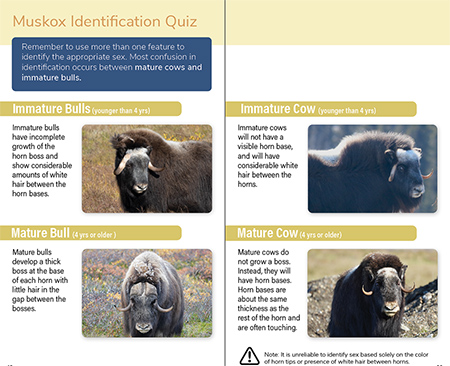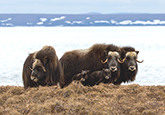Alaska Fish & Wildlife News
September 2021
Muskox Guide

Muskoxen, Alaska’s shaggy, hook-horned behemoths, are featured in an updated and redesigned pocket-size, full-color wildlife guide.
Muskoxen: A guide to identification, hunting and viewing was first published in 2010. A bit larger than a smartphone, the 40-page guide highlights muskox information such as distribution, life history, attributes and behavior; identification (by age and sex – and including an ID quiz); almost a dozen pages devoted to hunting, and a section on living with muskoxen for locals and visitors.
Heather Jameson, a wildlife education specialist based in Nome, served as the project leader and graphic designer. Jameson retained most of the original text while adding new diagrams, maps, photographs and illustrations. She and a committee of experts went over the previous guide for ideas for updates and improvements.
“The whole ID section is expanded with age, sex and seasons; the previous guide had a few pictures and examples,” she said. Both male and female muskoxen have horns . The appearance of muskox horns changes seasonally as they mature, and young adults (three-year-old bulls) in particular change over the course of a few months. Identification clues to age and gender such as behavior, horns – including the appearance of the tips and the horn boss (the thick base area), hair and body size are highlighted.

The hunting section includes requirements and general regulations, hunt planning, meat care, and hunt details specific to muskox. Jameson created a photo illustration to address a common hunter mistake - improper shot placement on these animals whose shaggy coat obscures their actual body contours.
“For the shot placement picture I had the Musk Ox Farm in Palmer take a picture of the skeleton and I superimposed that on a muskox (image), after digitizing it as a graphic representation,” she said.
The guide is available at Fish and Game offices across Alaska, in Nome and online as well. “You can pick them up in person, or download a PDF from the website,” Jameson said. “It’s pretty handy to download it to your phone and save it, then take it with you. You can zoom in on pictures, so it’s particularly good for wildlife viewing. With the different age classes you can narrow an animal down to male or female, and tell how old it is.”

Nome, on the Seward Peninsula about 525 miles west of Fairbanks, is surrounded by good muskox habitat. Jameson said there are herds of muskox in the Nome area and they can be seen right around town.
“You have an excellent chance of seeing a muskox in the Nome area, especially in spring, summer and fall,” Jameson said. “They stay up on the hillsides more in winter, where it’s more windblown and there’s less snow.”
Contact the Nome office for a copy of the guide, at 443-8196, or email heather.jameson @alaska.gov. Travelers planning a visit to Nome and the Seward Peninsula can also request a copy of Alaska’s Nome Area Wildlife Viewing Guide.

Alaska’s Nome Area Wildlife Viewing Guide
Nome and the Seward Peninsula Wildlife Viewing website
Mind your muskox manners coloring page, downloadable PDF
Subscribe to be notified about new issues
Receive a monthly notice about new issues and articles.
